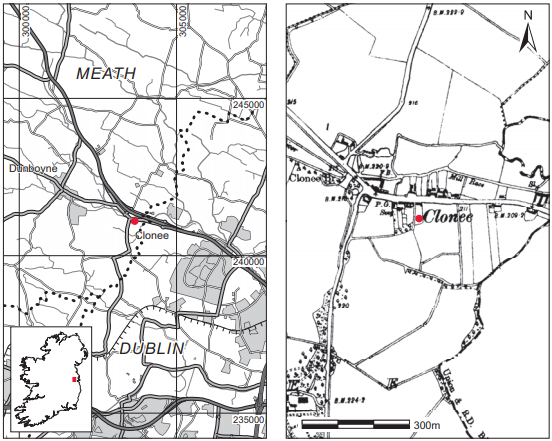County: Meath Site name: CLONEE, CO. MEATH
Sites and Monuments Record No.: SMR ME051-013 Licence number: E1130
Author: BREANDÁN Ó RÍORDÁIN
Site type: Late medieval graves, c. AD 12001600, and post-medieval graves, AD 16001800
Period/Dating: —
ITM: E 703603m, N 741127m
Latitude, Longitude (decimal degrees): 53.410101, -6.441704
Introduction
In July 1965, during the course of excavation of a septic tank, human remains were discovered on a building site at Clonee, Co Meath. The remains were found 0.5–0.76m below ground level but had been much disturbed at the time of examination. The discovery was reported to the Garda Síochána at Dunboyne, Co. Meath, on Saturday 10 July, and the NMI was informed the following Monday. Breandán Ó Ríordáin visited the site on 12 July and undertook a rescue excavation on 15 July. This report is based on Ó Ríordáin’s account of the site.
Location (Fig. 5.14)
The site was in the townland of Clonee in south-east County Meath, immediately adjacent to

Fig. 5.14—Location map, Clonee, Co. Meath.
the border with County Dublin.24 It lay between the former post office and the former police barracks in the village. The first edition (1840) of the Ordnance Survey sheet indicates the presence of a school on the site.
Description of site
Human remains were discovered over an area approximately 18m square.25 There was no evidence for stones that might have formed the grave lining. The graves appeared to be simple dug graves. No complete articulated skeleton was discovered; it was observed that burials seemed to lie at different depths as if they were at least partially superimposed, and that other skeletons appeared to have been disturbed by the insertion of later burials. The burials appeared to be aligned west/east. A number of clay pipe stems were found in the fill of the graves.
Comment
Ó Ríordáin suggested that the graves were probably post-seventeenth-century in date.26 While the bones were not retained, the excavator did note that some of the skulls were extremely thin and fragile and appeared to have belonged to the skeletons of children or young adults.
24. Parish of Dunboyne, barony of Dunboyne. SMR ME051-013——. IGR 303675 241103.
25. During his excavation, Ó Ríordáin uncovered skeletal remains at two points on the site. As no complete articulated skeleton was discovered, the graves are dealt with as one in this report, in accordance with the excavator’s notes.
26. Neither the clay pipe stems nor the human remains were retained.